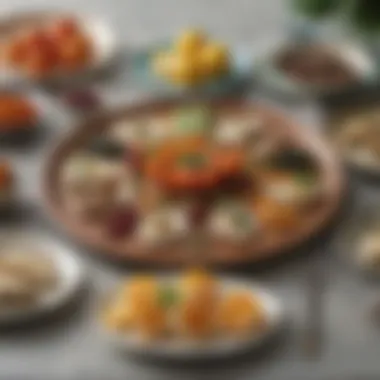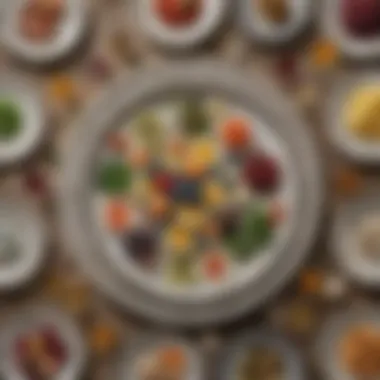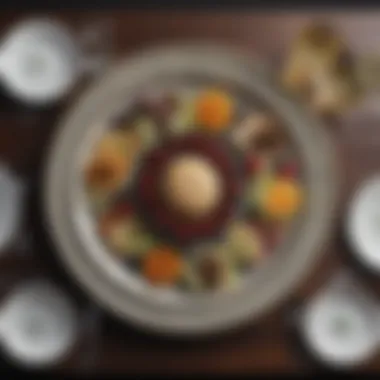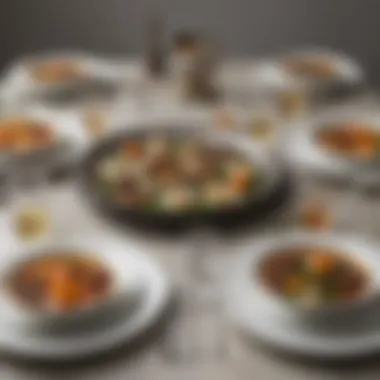Exploring Seder Plates: Tradition and Modern Adaptations


Intro
The seder plate is an integral part of the Passover celebration, symbolizing the historical journey of the Jewish people. It holds various elements that each represent a specific aspect of the Exodus story. This section will explore the meaning behind these elements and how they have evolved over time. As we investigate the nature of the seder plate, we will examine its historical origins, important components, its cultural symbolism, and modern reconceptualizations. The seder plate unravels complex themes of freedom, remembrance, and unity within the Jewish traditions, connecting contemporary observance to ancient practices. With growing diversity in Jewish experiences globally, the ways the seder plate is assembled and used have seen innovative adaptations, allowing for personal expression while honoring tradition.
As we look deeper into the content of this article, expect insights into various recipes that accompany these traditions, step-by-step guides on assembling a seder plate, tips for modern variations to suit dietary needs, and mental nutrition calculations that could guide culinary practices. We will present a blend of information which serves the culinary enthusiast, drawing attention to the intersection between ritual and daily practice.
More importantly, the discussions within this article will highlight how these seemingly simple dishes reflect rich cultural narratives, speaking not only to history but bringing forward individual stories of modern-day families. As we move forward, let us discover how the seder plate encapsulates stories of resilience, reinforces community bonds, and visually narrates a journey of survival and celebration.
Preamble to Seder Plates
The seder plate serves as a focal point during the Passover celebration, embodying the essence of a deeply rooted Jewish tradition. This introduction aims to establish the significance of the seder plate in both its historical context and contemporary practices. By understanding the nature of this sacred plate, one can appreciate not only the food it holds but also the stories and customs that surround it. The seder plate is a visual representation of the themes of freedom, slavery, and redemption.
Definition and Importance
A seder plate is traditionally used during the Passover meal, known as the Seder. It typically contains symbolic foods that represent different aspects of the Passover story. The description of the plate often emphasizes that it carries a rich mixture of meaning and memory. Each item on the plate corresponds to a specific aspect of the Seder. For example, maror, or bitter herbs, symbolize the bitterness of slavery, while charoset reflects the mortar used by enslaved ancestors. Thus, the seder plate is more than just a collection of food items; it is a conversation starter and an educational tool that connects generations. This connection between past experiences and present celebrations underlines the importance of seder plates in Jewish households.
Historical Context
The concept of the seder plate can be traced back to various historical texts and practices within Judaism. Its roots are found in the story of the Exodus from Egypt, a central narrative in Jewish history and religious observance. The tradition began taking shape during Talmudic times, around 200-500 CE, when the Seder meal evolved with rituals and symbols that can be identified today. The evolution of the seder plate reflects both response to historical contexts and adaptations of cultural insights throughout centuries.
Moreover, local customs played a role in shaping the specifics of the seder plate. For instance, during the Middle Ages, Ashkenazi and Sephardic Jews adopted distinct symbolism and styles. This divergence contributes to not only a broader understanding of cultural traditions but also to the richness of discussions around the Seder. With each generation, new layers of meaning are added, resulting in variations that allow individuals and families to enrich their celebrations in connection to ancient customs. Many modern interpretations do continue to honor the original functions; some additional interpretations could show situational storytelling related to personal or communal experiences at Passover.
Understanding the seder plate is not simply an examination of its functions, but also reflects how centuries of interpretation have added to its depth and relevance in current times.
Key Components of Seder Plates
Understanding the key components of seder plates helps illustrate their importance in the ritual of Passover. Every item on the plate holds deep meaning and is not simply a decorative element. It is crucial for the Seder, a Jewish ritual meal, instilling a sense of heritage and spirituality among participants. Here, we will explore the symbolic foods featured on the seder plate and the plate itself.
The Symbolic Foods
Each food item on the seder plate carries monumental significance. They are not just ingredients, but symbols representing key elements of the Passover narrative and themes.
- Maror (Bitter Herbs): Typically made from horseradish, they signify the bitterness of slavery endured by the Israelites.
- Charoset: A mixture of fruits and nuts, its sweet taste symbolizes the mortar used byiv slaves to build structures in Egypt.
- Karpas (Vegetable): Often parsley, indicating springtime and the renewal of life; it is dipped in salt water to recall tears of oppression.
- Zeroa (Shank Bone): This symbolizes the paschal lamb, representing sacrifice and freedom that the Israelites experienced during the Exodus.
- Beitzah (Egg): A sign of mourning, but also symbolizes renewal and hope in the process of redemption.
- Chazeret (Second Bitter Herb): Sometimes romaine lettuce, it reinforces the theme of bitterness connected with slavery.
The makeup of these foods composes not only a diverse palette for the Seder tables but evokes memories and emotions through tangible items, further linking tradition with food.
The Plate Itself
The seder plate is equally important in this significance. Usually circular, it consists of distinct compartments, each designated for one of the symbolic foods. The design may vary but often reflects cultural or familial customs. Shapes, colors, and the materials may possess personal or artistic meaning for the family.
- Material Choices: Plates may be made from several materials such as ceramics, stainless steel, or even silver. Each can convey wealth, tradition, or both.
- Artistic Design: Many plates feature engravings or artistic patterns that illustrate a profound connection to Jewish traditions.
- Orientation: In many households, the seder plate is placed at a focal point during the meal to signify its importance in the ritual.
These factors collectively enhance the visual and ceremonial aspects of the Seder, providing a rich backdrop to the celebration.
The seder plate not only holds symbolic foods. It is the centerpiece of discussions, reflections, and storytelling that encompass the essence of exposition for Passover.
Overall, the careful selection and arrangement of symbolic foods and their accommodating plates play pivotal roles during the Passover rituals, knitting family history and collective Jewish culture through nourishment and shared experiences.
Traditional Foods on the Seder Plate


The traditional foods on the seder plate hold significant importance for Jewish families during Passover. Each item represents key elements of the Passover story, emphasizing themes of redemption, struggle, and starting anew. Understanding these foods enhances the ritual's depth, bringing families together while imparting crucial historical stories through shared meals.
Maror (Bitter Herbs)
Maror, often horseradish, symbolizes the bitterness of slavery the Jewish people faced in ancient Egypt. The act of consuming maror serves as a poignant reminder of the hardships endured. Traditionally, it is placed prominently on the seder plate, in a small portion to highlight its powerful meaning. The sharp and intense flavor of maror evokes a physical reaction, enhancing the emotional connection to the memories of suffering.
Maror's role in the seder is not to overwhelm but to provoke thought and reflection. This bitter herb reminds participants to be aware of historical persecution, connecting them to generations before who faced these hardships.
Charoset
Contrasting the bitterness of maror, charoset represents the mortar used by the Israelistes while enslaved. Typically a sweet mixture of apples, nuts, wine, and spices, charoset is not only a dessert but epitomizes a connection to the laborious activities rooted in historical suffering. The sweetness of charoset serves to balance the intensity of the other components on the plate, symbolizing hope and the promise of freedom.
In modern observance, many families personalize their charoset recipes. Variations may include local fruits or nuts, reflecting individual family heritage and contemporary tastes. This adaptability makes charoset a bridge between tradition and innovation, celebrating both the past and the present within a meaningful context.
Karpas (Vegetable)
Karpas usually refers to parsley or another green vegetable dipped in saltwater, symbolizing springtime and renewal. The act of dipping the karpas is significant as it reminds participants of the tears shed during slavery. It provides a dual symbolism: representing both hope for liberation and the sorrow of the past.
Typically, one bite is taken to mark the start of the meal, grounding the seder in a moment of reflection. It connects participants deeply to the cycle of life and nature, emphasizing rebirth and renewal.
Zeroa (Shank Bone)
The zeroa, a roasted shank bone, symbolizes the Passover sacrifice. It serves as a reminder of the lamb sacrificed before the Exodus. For centuries, the ritual of remembering this act has persisted through familial traditions. The residue of the establishment of ritual observance invites conversation.
Zeroa reminds families of the birth of a new nation based on freedom. Participants are often led to discuss implications and memories associated with rites of passage, grounding both personal and collective histories.
Beitzah (Egg)
The beitzah, or roasted egg, signifies the festival sacrifice and rebirth. It possesses a dual nature: linking to mourning of the past and yet resonating with life's cyclic nature. As an egg represents new life, the intense passing of time warrants contemplation about continuity, memory, and growth through hardship.
Often, families will cook their beitzah differently based on generational tastes. This reveals how traditions can evolve while still honoring their poignant roots.
Chazeret (Second Bitter Herb)
For some communities, chazeret, usually more bitter herbs like romaine lettuce, is included alongside maror. Its incorporation underscores the prevalence of bitterness in the Haggadah narrative. While not universally observed, this legume brings extra weight to the ceremony, affirming that struggle was a profound and multi-faceted experience.
Depending on personal or community preferences, the arrangement may vary, but its existence projects several deeply empathetic dialogues about suffering and overcoming adversity.
Reflection on Seder Foods: The assortment of foods on the seder plate tells a story goes beyond mere sustenance. These items carry historical weight and serve as catalysts for personal and collective reflection. In observing the night of remembering, one contemplates the unyielding relevance of these themes across different times and customs.
The Role of Seder Plates in Passover Rituals
The role of seder plates during Passover is crucial in maintaining the age-old customs that celebrate the liberation of the Jewish people from slavery in Egypt. Seder plates serve not only as a vessel for symbolic foods but also as a focal point for the entire observance of the holiday. Through this plate, updated over generations, families reconnect with their heritage while creating vivid memories around long-held traditions.
Seder Night Practices
During the Seder night, when families gather to perform the rituals, the seder plate becomes essential. This night is filled with various significant rituals like reading the Haggadah, recounting the exodus story, and enjoying a festive meal. The plate collectively authorizes all these practices centered on the themed items placed on it. Each item, from maror to charoset, expresses the multifaceted experience of suffering and freedom.
The placement and presentation of these foods allow each participant to engage with the symbolism directly. For example, the bitter herbs, maror, symbolize the bitterness of slavery, providing participants an emotional link to their past.
Furthermore, sharing responsibility in carrying out these practices fosters community and unity among families. It helps breed an experience that resides both in the heart and the memory, making it more influential than a mere meal. Such cultural or spiritual significance aids in educating the younger generations on important values.


Family and Community Gatherings
Family and community gatherings during Passover revolve around the seder plate, celectating shared experiences and stories. These gatherings symbolize unity as everyone comes together, reaffirming their story and faith.
In larger gatherings, each household might bring a unique seder plate, reflecting individual traditions and recipes. This presents a tapestry of flavors and stories that bind the community. Special adaptations can be found; some may opt for completely vegan interpretations like tofu for karpas or pursue a gluten-free approach for the matzah.
Additionally, communal seders are becoming more common in non-traditional Jewish spaces. The enriching dialogue about sexism, migration, and inequality can incite vital conversations. Through these large or intimate gatherings, seder plates inspire not only a remembrance of the Exodus but also help participants make connections with broader societal themes.
By nurturing an environment that encourages dialogue, engaging topics throughout the Seder enhances one's understanding of tradition while connecting to contemporary narratives. Therefore, seder plates, in their essence, play a deciding role in these rituals during Passover, grounding practices from the past to present gatherings.
Modern Interpretations of Seder Plates
Modern interpretations of seder plates reflect a vibrant blend of tradition and innovation, addressing new generations of Jewish families while encouraging the central tenets of Passover. In an era of globalization and connectivity, many Jewish communities and individual practitioners find inspiration in diverse cultural backgrounds, leading to an evolved understanding of this meaningful ritual as it bridges the past with contemporary values.
Cultural Adaptations
The core components of the seder, particularly the seder plate's offerings, have been subject to cultural adaptations based on geographic or ethnic origins. Factors such as local cuisine and family history often inspire changes in traditional food items or the style of presentation. For instance:
- Ashkenazi Variations: In Eastern European traditions, you might find traditional fare like gefilte fish and horseradish integrated into a creative twist on the seder plate, introducing these culinary favorites.
- Sephardic Innovations: Layana or dried fruit might be present on the plate in Sephardic households, as they symbolize abundance and memory of Jewish farming limitations in the Mediterranean region.
Such adaptations often encourage exchange among families during the holiday, giving space to share not just recipes but also stories and memories. Reflected through meals, these cultural exchanges bring richness and complexity that maintain connectedness among generations.
Personalization and Creativity
Another aspect of modern interpretations consists of personalization and creativity. One can see this in various recent practices:
- Handcrafted Elements: A growing number of families choose handmade plates or individually crafted recipes, celebrating the creativity involved in preparing each year’s meal.
- Themed Seders: Individuals often set themed seders that reflect their interests or values, ranging from ecological consciousness to art and literature. Each food chosen may serve both symbolic purposes as well as thematic cohesion.
This avenue of creativity encourages participants to go beyond standard practices, allowing freedom to express personal and community identities, melding tradition while underscoring contemporary relevance.
By adapting and personalizing their seder plates, today's Jewish families breathe life into their Passover traditions, maintaining permanence while promoting innovation.
Engaging with these trends offers an enriched experience. Families have the chance to discuss and reflect on their choices, acknowledging ancient customs while staying true to their own unique narratives in this celebrated time.
Seder Plates Across Different Jewish Communities
Seder plates play a significant role in the diverse customs of Jewish communities globally. While the fundamental purpose remains constant, variations in practice highlight cultural nuances and local flavors. Each community's interpretation impacts both the experience of the Seder and the ways traditions are passed down.
Ashkenazi Traditions
Ashkenazi Jews primarily hail from Central and Eastern Europe. Their Seder plates often reflect agricultural practices and local culinary ingredients. For them, maror, symbolizing bitter experiences, is typically prepared with horseradish. Its pungent flavor serves as a potent reminder of hardship.
The charoset also takes on a distinct form; it usually combines apples, walnuts, and sweet red wine. This mixture catered to available ingredients in the region, symbolizing the mortar used by Jewish slaves in ancient Egypt. Distinct texts accompanying the Seder prayers reaffirm Ashkenazi heritage, revealing deep emotional connections to historical suffering.
Furthermore, the chaos surrounding modern Ashkenazi Seder celebrations bears witness to an evolving tradition, adapting with globalization.
“The Seder becomes a narrative, a story told and retold, not merely through words, but through the ingredients on the plate.”
Sephardic Practices


In contrast, Sephardic Jews, originating from Spain, Portugal, and North Africa, have unique customs reflected in their Seder plates. Typically, a more varied range of flavors is employed. For example, they might include raw fruit, such as pomegranates, which hold rich biblical significance.
Their charoset recipe often diverges from the one cherished by Ashkenazim, incorporating figs or dates alongside nuts and sometimes offerring a spicier element with the use of cinnamon.
Sephardic plates might also show a notable focus on community gatherings. Family and friends merge their culinary practices, combining flavors and traditions. This exchange often epitomizes their Seder as a collective experience, integrating cultural images.
Mizrahi Perspectives
Mizrahi Jews, originating from the Middle East and North Africa, present another layer of diversity. Their Seder plates may exhibit a distinctly spicy character through the inclusion of horseradish alongside distinct local dishes influenced by regional spices.
Symbolism continues through various food items; one prevalent element is artichokes, representing joy and renewal. Their Seder practices emphasize the ideas of liberation and survival, identifying local customs which often blend contemporaneous food trends with historical contexts.
Mizrahi traditions showcase adaptations birthed during migration, illuminating resilience and regard for senses. The combination portrays a culinary heritage enriched by historical journeys and existential struggles, underscoring the crucial task of preserving deeply-held beliefs.
In summary, Seder plates across different Jewish communities embody unique traditions, ingredients, and interpretations reflecting local customs. Regardless of background, these practices contribute richly to the universal message of Passover—freedom and remembrance. These differences enrich the broader Jewish mosaic, ultimately enhancing the celebratory nature of the Seder evening.
Crafting a Seder Plate
Crafting a seder plate blends tradition with personal expression. This act goes beyond mere assembly; it involves an exploration of cultural significance and culinary choices. The process can offer insight into one’s heritage and provide an opportunity to engage others in dialogue about the customs surrounding Passover.
Selecting the Right Plate
The selection of the plate is the cornerstone of crafting a seder plate. One may consider various materials such as ceramic, glass, or metal. Each has its own aesthetic and nostalgic value. Quality should also be taken into account, ensuring the plate withstands the weight of symbolic foods and is easy to handle.
Choosing the plate also reflects personal taste and style. Some prefer ornate designs that echo historical motifs, while others may opt for modern aesthetics. Furthermore, practicality is paramount. A larger plate may be ideal for a feast, but smaller options work for more personal settings.
Preparing the Symbolic Foods
The next step involves the careful preparation of the symbolic foods. Each element carries profound meanings and contributes to the seder narrative. Preparation methods can vary; some families may choose to make dishes from scratch, while others may prefer convenience. The above mentioned foods include:
- Maror: Coltsfoot, horseradish, or romaine lettuce;
- Charoset: A sweet mixture of fruits and nuts;
- Karpas: Generally parsley with saltwater;
- Zeroa: A roasted shank bone;
- Beitzah: A hard-boiled egg;
- Chazeret: Another form of bitter herb, often romaine.
Quality and fresh ingredients elevate the overall experience. Each food can create discussions and reflections on their symbolism during the seder.
Adding Personal Touches
The final facet of crafting a seder plate involves adding personal touches that resonate with the individual or family's unique history.
This aspect could range from simple factors such as:
- Selecting unique bowls for the symbolic foods;
- Adding family heirlooms on the table;
- Arranging the foods in a meaningful layout;
Creating an environment that encourages reflection is key. Many might write personal notes related to their faith or ancestors on the plate or additional prints around the setup.
Ultimately, each seder plate serves as a reflection of the past and a testament to the enduring human connection to tradition.
Ending
Reflecting on Tradition and Innovation
The exploration of seder plates throughout this article highlights their profound significance in Jewish culture, particularly during the celebration of Passover. The uniqueness of the seder plate lies not only in its rich history and traditional components but also in how it serves as a canvas for personal expression and community values. Throughout history, the seder plate has encapsulated essential symbols of freedom, resilience, and remembrance, allowing families and communities to connect with their heritage.
In modern times, the shift towards personalization and creativity has infused the seder plate with fresh interpretations. Individuals increasingly adapt the ceremonial plate to reflect their personal stories, dietary preferences, and cultural mishmash. The freedom to include alternative ingredients allows diverse voices within the Jewish community to assert their identities and backgrounds, enriching the Passover experience.
Understanding the seder plate signifies more than just food presentation. Rather, it bears witness to traditions that bridge generations, signaling an embrace of innovation without relinquishing the customs that shape collective memory.
"A seder plate is a reminder of who we are and where we come from. Its evolution is an intersection of tradition and the here and now."







